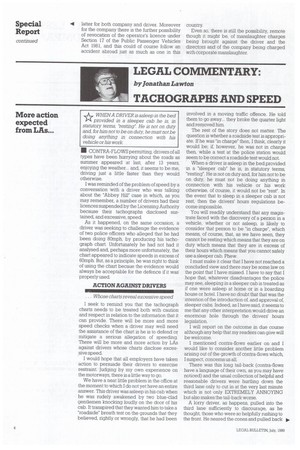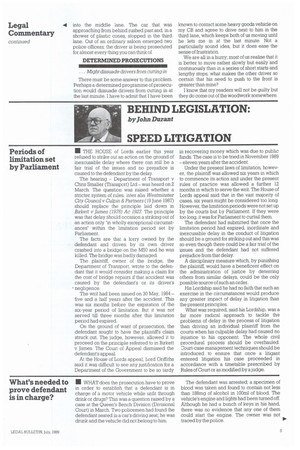LEGAL COMMENTARY:
Page 112

Page 113

If you've noticed an error in this article please click here to report it so we can fix it.
by Jonathan Lawton
TACHOGRAPHS AND SPEED
WHEN A DRIVER is asleep in the bed PA provided in a sleeper cab he is, in statutory terms, 'resting". He is not on duty and, for him not to be on duty, he must not be doing anything in connection with his vehicle or his work • CONTRA-FLOWS permitting, drivers of all types have been hurrying about the roads as summer appeared at last, after 13 years, enjoying the weather... and, it seems to be me, driving just a little faster than they would otherwise.
I was reminded of the problem of speed by a conversation with a driver who was talking about the "Abbey Hill" case in which, as you may remember, a number of drivers had their licences suspended by the Licensing Authority because their tachographs disclosed sustained, and excessive, speed.
As it happened, on the same occasion, a driver was seeking to challenge the evidence of two police officers who alleged that he had been doing 80mph, by producing his tachograph chart. Unfortunately he had not had it analysed and, perhaps more unfortunately, the chart appeared to indicate speeds in excess of 60mph. But, as a principle, he was right to think of using the chart becaue the evidence would always be acceptable for the defence if it was properly used.
I seek to remind you that the tachograph charts needs to be treated both with caution and respect in relation to the information that it can provide. There will be more and more speed checks when a driver may well need the a acistance of the chart is he is to defend or mitigate a serious allegation of speeding. There will be more and more action by LAs against drivers whose charts disclose excessive speed.
I would hope that all employers have taken action to persuade their drivers to exercise restraint. Judging by my own experience on the motorways, there is a little way to go.
We have a neat little problem in the office at the moment to which I do not yet have an entire answer. This driver was asleep in his cab when he was rudely awakened by two blue-clad gentlemen knocking loudly on the door of his cab. It transpired that they wanted him to take a "roadside" breath test on the grounds that they believed, rightly or wrongly, that he had been involved in a moving traffic offence. He told them to go away... they broke the quarter light and removed him.
The rest of the story does not matter. The question is whether a roadside test is appropriate. If he was "in charge" then, I think, clearly it would be; if, however, he was not in charge then, while a test at the police station would seem to be correct a roadside test would not.
When a driver is asleep in the bed provided in a "sleeper cab" he is, in statutory terms, "resting". He is not on duty and, for him not to be on duty, he must not be doing anything in connection with his vehicle or his work otherwise, of course, it would not be "rest". In the event that to sleep in a sleeper cab is not rest, then the drivers' hours regulations become impossible.
You will readily understand that any magistrate faced with the discovery of a person in a vehicle, whether or not asleep, is likely to consider that person to be "in charge", which means, of course, that, as we have seen, they cannot be resting which means that they are on duty which means that they are in excess of their hours which means that you cannot safely use a sleeper cab. Phew.
I must make it clear that I have not reached a concluded view and there may be some law on the point that I have missed. I have to say that I hope that, whatever disadvantages the police may see, sleeping in a sleeper cab is treated as if one were asleep at home or in a boarding house or hotel. I have no doubt that that was the intention of the introduction of, and approval of, sleeper cabs. Indeed, as I have said, it seems to me that any other interpretation would drive an enormous hole through the drivers hours legislation.
I will report on the outcome in due course although any help that my readers can give will be welcome.
I mentioned contra-flows earlier on and I would like to consider another little problem arising out of the growth of contra-flows which, I suspect, concerns us all.
There was this long tail-back (contra-flows have a language of their own, as you may have noticed) and the usual collection of helpful and reasonable drivers were hurtling down the third lane only to cut in at the very last minute which is not only EXTREMELY ANNOYING but also makes the tail-back worse.
A lorry driver, as happens, pulled into the third lane sufficiently to discourage, as he thought, those who were so helpfully rushing to the front. He neared the cones and pulled back 0. • into the middle lane. The car that was approaching from behind rushed past and, in a shower of plastic cones, stopped in the third lane. Out of an ordinary saloon emerged two police officers; the driver is being prosecuted for almost every thing you can think of.
There must be some answer to this problem. Perhaps a determined programme of prosecution would dissuade drivers from cutting in at the last minute. I have to admit that I have been known to contact some heavy goods vehicle on my CB and agree to drive next to him in the third lane, which keeps both of us moving until he lets me in at the last minute. Not a particularly sound idea, but it does ease the sense of frustration We are all in a hurry; most of us realise that it is better to move rather slowly but easily and continuously than in a series of short starts and lengthy stops; what makes the other driver so certain that his need to push to the front is greater than mine?
I know that my readers will not be guilty but they do come out of the woodwork somewhere.




















































































































